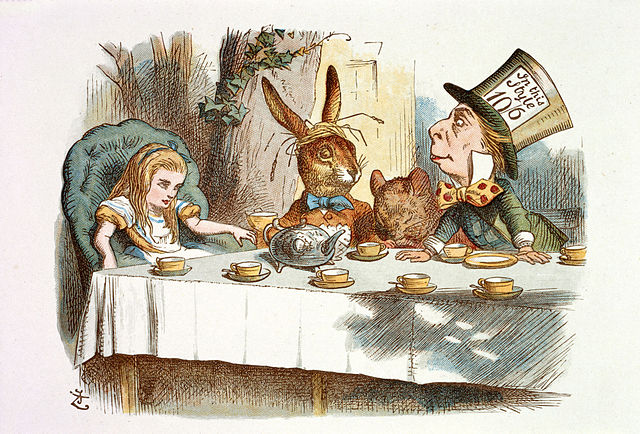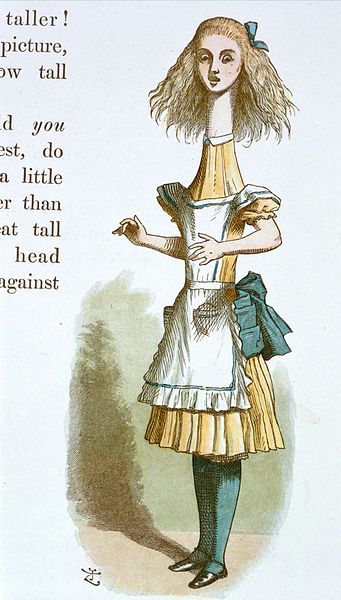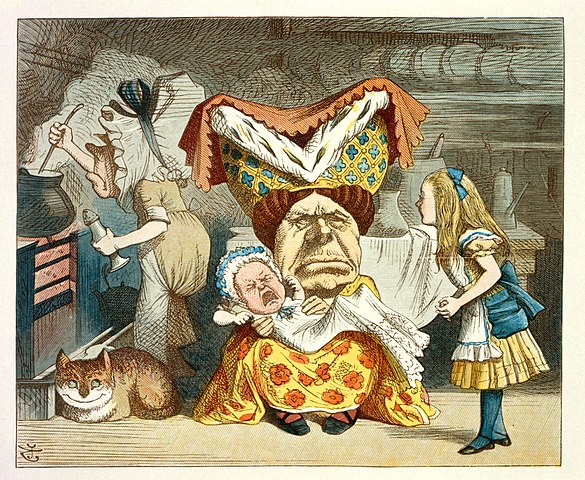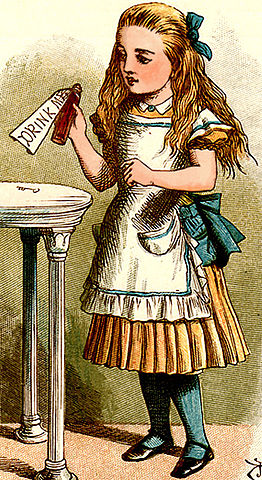
The Thammasat University Libraries have newly acquired a biography of the British author Lewis Carroll, whose most famous work is Alice in Wonderland.
Charles Lutwidge Dodgson (1832–1898), who wrote using the pen name Lewis Carroll, was not just a writer of books for children. He was also a mathematician, logician, Anglican deacon, and photographer. Many myths have arisen around him, so Lewis Carroll: The Man and His Circle by Edward Wakeling is useful for getting to understand his achievement better. Alice’s Adventures in Wonderland (1865), usually referred to as Alice in Wonderland, is about a girl named Alice who falls through a rabbit hole into a fantasy world full of odd creatures. In its sequel, Through the Looking-Glass, and What Alice Found There (1871), Alice goes into another fantasy world by climbing through a mirror. In both books, the dream-like events and sometimes sarcastic speech of the characters are charming and memorable. Earlier biographers claimed that in his life, Carroll was only interested in young girls to the exclusion of all other people, and this is not true. He created many strange visions in the Alice books, especially large talking animals such as the White Rabbit, the Caterpillar, the Cheshire Cat, the March Hare, the Dormouse, and the Mock Turtle. Some previous writers have claimed that these odd visions may have been inspired by drug abuse, but Lewis Carroll: The Man and His Circle convincingly argues that this is unlikely.
A bestseller.
Alice in Wonderland was an immediate hit with readers, including such fans as Queen Victoria and the Irish writer Oscar Wilde. It has been translated into around 175 languages, including Thai. Through the Looking Glass has also been translated into Thai language. There have been many adaptations of the book for the stage, screen, and television. Many people are familiar with Tim Burton’s 2010 film Alice in Wonderland starring Johnny Depp. Yet the first movie version of Alice in Wonderland was made over a century ago, in 1903. This British silent film was a hit, as were other silent versions in 1910 and 1915. The first talking film version of Alice in Wonderland was in 1931, followed by another in 1933. The latter film was a Hollywood extravanganza, starring W. C. Fields, Edna May Oliver, Cary Grant, Gary Cooper, and Edward Everett Horton. Many other versions followed until the 1951 Walt Disney animated film which is still appreciated.

Thailand and Alice in Wonderland
The novel Thawiphop (Parallel Worlds) by Wimon Siriphaibun (Khun Ying Wimon Chiamcharoen), who writes under the pen name Thommayanti (also transliterated as Tamayanti), brought themes from Alice in Wonderland to the Thai public. A historical fantasy romance novel, Thawiphop tells the story of a Thai socialite who travels through a mirror just like Alice through her looking glass, going back in time from the 20th century to Siam in the era of Rama V. The popular story was adapted as a film by the director Cherd Songsri (1931-2006) in 1990, as well as a stage play, musical, television series and another film in 2004 (Siam Renaissance).

As a TV soap opera, Tawipob (1994) or Tawee Pope, starring Sarunyu Wongkrajang and Siriam Pakdeedumrongrit, reached perhaps its biggest audience. Still remembered fondly by fans of the lakorn (television play), the idea of a nang’ek (leading lady) traveling through a mirror to meet a pra’ek (leading man/hero) captured the imagination of viewers. Maneechan, a diplomat investigating recently uncovered documents in France concerning ancient Thailand, learns the story behind them as she travels back in time through the mirror.
Academic analysis.
The TU Libraries own a copy of Contemporary Socio-Cultural and Political Perspectives in Thailand, edited by Pranee Liamputtong, a professor in the College of Science, Health and Engineering of La Trobe University, Australia. Dr. Pranee, a medical anthropologist, included in this book a thought-provoking essay, The Thawiphop Phenomenon: Reimagining Nationalism in a Contemporary Thai Novel and Its Stage and Screen Adaptations. This chapter is by Dr. Morakot Jewachinda-Meyer, a lecturer at Mahidol University, who writes:
I argue that the Thai public’s consumption of Thawiphop in its various versions reveals a new terrain of interrelation between forms and practices of entertainment, on the one hand, and the dynamism of nationalist culture in modern Thailand, on the other. The novel and its adaptations are products of wider developments in Thailand during the late Cold War and the following two decades. Thawiphop takes Lewis Carroll’s legendary books Alice in Wonderland and Through the Looking Glass (2006) as its inspiration and becomes itself a mirror of the Thai middle class’s identity and of the interaction of middle-class Thais with national, regional, and global developments.

Dr. Morakot suggests that Thawiphop is heavily inspired by Lewis Carroll’s Alice books. Reimagining the history of the late nineteenth-century Thailand, Thawiphop is essentially an escapist fantasy. Its heroine chooses to remain in the fantasy land she arrived at through the mirror. By contrast, Lewis Carroll’s Alice, after experiencing delirious adventures, is always happy to return home. Dr. Morakot points out that Thawiphop is in the tradition of Si Phaendin (1953), an historical novel with added love interest, translated as Four Reigns. Its author, Mom Rajawongse (M.R.) Kukrit Pramoj, who would later serve as prime minister of Thailand, told the story of Mae Ploy, a young servant of a princess of Rama V’s Royal Household. Like Four Reigns, Thawiphop focused on a woman’s point of view. Yet in Thommayanti’s narrative, the heroine shows no interest in returning to modern-day Thailand, preferring a luxurious exile in the comforts of the past. Dr. Morakot adds:
In the late nineteenth-century Britain, Alice – the famous children’s book character created by Lewis Carroll… enjoys time galore in the fantasy world down the rabbit hole and in the looking-glass house. Across the Indian Ocean in the late 1980s, Thailand witnessed the debut of Maneechan or Manee, the protagonist of the novel Thawiphop (Parallel Worlds). A beautiful young lady, Manee uses a standing mirror to travel back and forth between the present and the fantasized past of Thailand or Siam as the country was known before 1939. After her adventures in the fantasy world, Alice comes back to her house and presumably goes on to enjoy her life in the British Empire of her times. By contrast, Manee never returns from her final sojourn in the parallel world. She makes a conscious decision to live her life in the fantasized past of the mid-nineteenth-century Siam, where she has developed genuine love for Dhep, a young noble who works in the royal foreign affairs service. Manee’s and Dhep’s relation, however, cannot be reduced to romantic love; they are also bound together by their passion for defending the nation from the encroachments of Western imperialism.
The idea of a Thai Alice who voluntarily escapes forever from her country and time might have seemed unusual even to the lively imagination of Lewis Carroll.

(all images courtesy of Wikimedia Commons)
